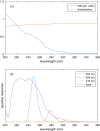Ultraviolet absorption of contaminants in water
- PMID: 33574493
- PMCID: PMC7878760
- DOI: 10.1038/s41598-021-83322-w
Ultraviolet absorption of contaminants in water
Abstract
Contaminants in water were studied using ultraviolet absorption with light emitting diode and deuterium lamp sources, and a thresholding detector. The absorption spectra of potassium hydrogen pthalate, clothianidin, tryptophan, thiamethoxam, uric acid and metaldehyde were obtained in the range 200-360 nm. Only metaldehyde was not suitable for detection in this range. For the other contaminants, and mixtures of pairs of compounds, the transmitted signal could be approximately described with a simple spectral model of the source-absorption-detector system. Combined measurements at two wavelengths could allow relative concentrations in certain mixtures to be determined, and real-time absorption measurements were demonstrated in a flume.
Conflict of interest statement
The authors declare no competing interests.
Figures





References
-
- Schwarzenbach RP, Egli T, Hofstetter TB, von Gunten U, Wehrli B. Global water pollution and human health. In: Gadgil A, Liverman DM, editors. Annual Review of Environment and Resources. 2010. pp. 109–136.
-
- Pietrzak D, Kania J, Malina G, Kmiecik E, Wator K. Pesticides from the EU first and second watch lists in the water environment. Clean Soil Air Water. 2019 doi: 10.1002/clen.201800376. - DOI
-
- de Souza RM, et al. Occurrence, impacts and general aspects of pesticides in surface water: A review. Process Saf. Environ. Prot. 2020;135:22–37. doi: 10.1016/j.psep.2019.12.035. - DOI
Publication types
LinkOut - more resources
Full Text Sources
Other Literature Sources

